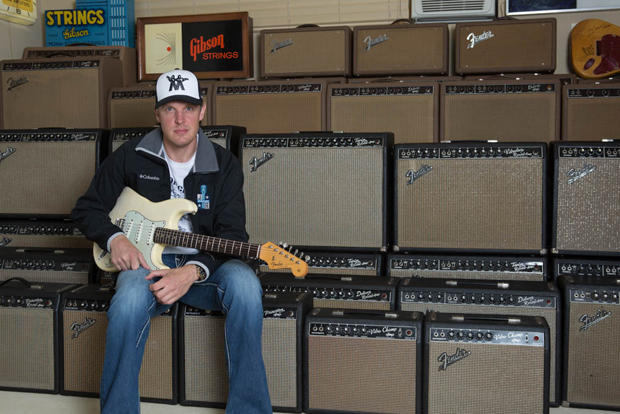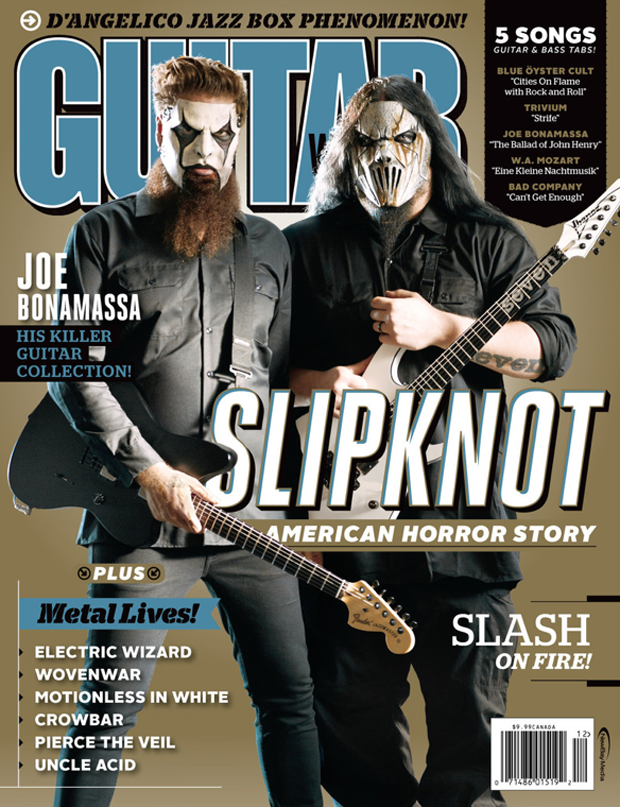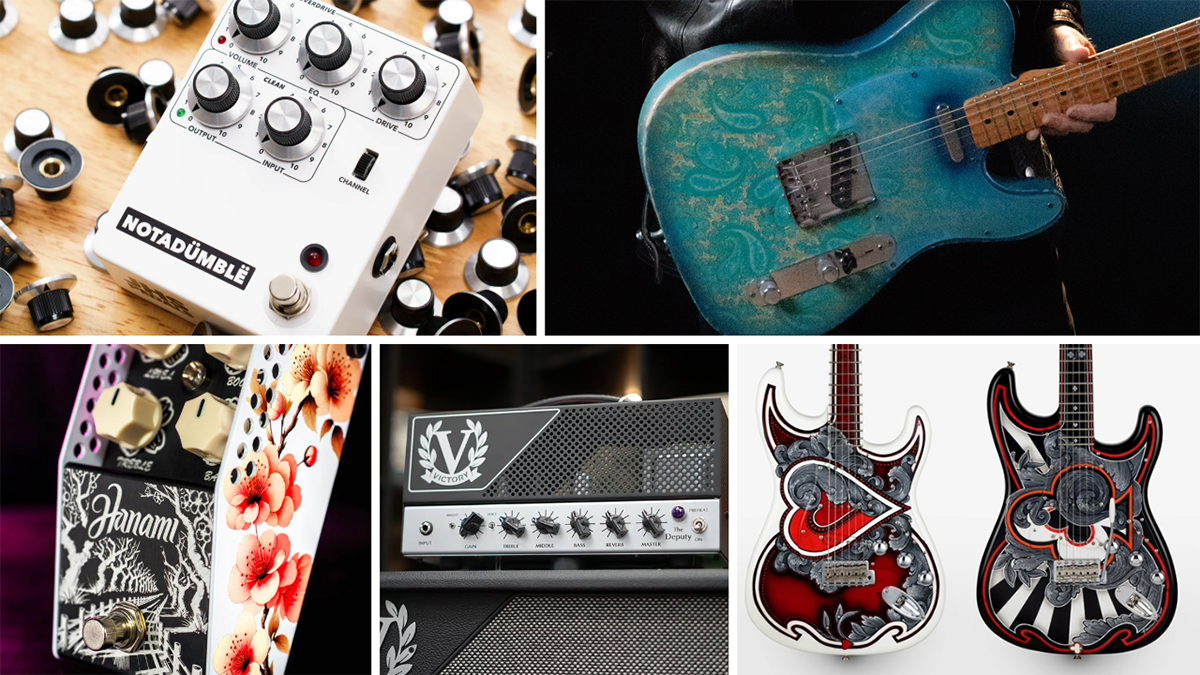Joe Bonamassa Talks Fender Strats and His New Album, 'Different Shades of Blue'

This is an excerpt from the December 2014 issue of Guitar World. For the rest of this Joe Bonamassa story, plus features on Slipknot, Slash, Lenny Kravitz, Paul Gilbert, Motionless In White, Electric Wizard and more, including lessons, tabs and reviews of new gear from D'Angelico, Washburn, Boss, Morley, Lace Music and Carr Amps, check out the December 2014 issue at the Guitar World Online Store.
The House Is Rocking: To celebrate the release of his new album, Different Shades of Blue, Joe Bonamassa invites us over for a look at his ever-growing collection of vintage axes and amps.
“There’s nothing on my new album that’s going to outplay Clapton, Hendrix or the other greats,” says six-string roots-and-rock rabble-rouser Joe Bonamassa. “That’s not what I’m trying to do. My job in 2014 is to keep that kind of organic music alive.”
For Bonamassa, that means fanning the flames of the blues. So after recording his new
Different Shades of Blue
, he headed to Colorado’s famed Red Rocks Amphitheater in late August to build a bonfire—playing a sold-out concert with a set list culled from the catalogs of genre giants Muddy Waters and Howlin’ Wolf that was shot for DVD.
“We had 10,000 people,” he says. “That’s what I call ‘proof of life.’ There’s always talk about the blues dying out, but it won’t. You just have to make it a little different. That’s where the Black Keys and Jack White have succeeded and I’ve failed. They’ve actually convinced college kids that they’re listening to hip music—but it’s just blues twisted a new way—while I’m playing for the college kid’s parents.”
That’s not entirely true. Bonamassa’s broadsword tone, conflagrant licks, dusted-soul singing and cinematic songs have sliced through the striations of demography with an efficiency unseen by any roots-based guitar slinger since Stevie Ray Vaughan. He’s a social-media darling who sells out auditoriums and amphitheaters in a flash. And despite putting out his own albums and DVDs, he’s hit Number One on the
Billboard
blues chart a record dozen times, sells more music than most major-label artists and was nominated for a Grammy in 2013. No wonder the guy owns one of every Gibson Les Paul made between 1952 and 1961, including the two 1959s—his beloved “Spot” and “Principal Skinner” Les Paul Standards—that he played on
Different Shades of Blue
.
Bonamassa’s fortunes turned north when he kicked the beer-and-barbecue circuit in favor of partnering with his producer, Kevin Shirley, a decade ago. Their alchemical mix of music and marketing smarts has resulted in gold. But
Different Shades of Blue
has a slightly different sheen, raising the already high bar of their studio craftsmanship a few more clicks.
There’s even an overture, signaling that something special is afoot, to set up the 10 original tunes. It’s an instrumental excerpt of Jimi Hendrix’s “Hey Baby (New Rising Sun)” that does justice to the original’s sharp-tooted Strat tones. Bonamassa keeps moving like a single-coil shark into “Oh Beautiful,” tastefully coloring his howling expressionist solo with a patina of phase shifter.
The intro to “Never Give All Your Heart” recalls Pete Townshend’s
Who’s Next
–era high-wattage humbucker clangor as it takes Bonamassa back to his beloved Les Pauls. By the time the 37-year-old guitar slinger steps up to solo in that tune, his tone has shifted to a sophisticated-but-brass-knuckled distillation of British blues blasters, ranging from Jimmy Page to David Gilmour, yet his phrasing is the unique blend of elongated melody and textural grit that has become Bonamassa’s own trademark. As
Different Shades of Blue
ends with the ballad “So, What Would I Do,” it’s clear that in the two years since his previous studio recording Driving Toward the Daylight Bonamassa has revised his sound and refined his songwriting and vocal delivery to land on a new and very high creative plateau.
After 20-something studio recordings, live albums and DVDs, Bonamassa and Shirley went searching for new fuel for
Different Shades of Blue
. They found it in Nashville, where Bonamassa traveled five times in the past year for marathon songwriting sessions with ace tunesmiths James House, Jerry Flowers, Jonathan Cain, Jeffrey Steele and Gary Nicholson.
“Kevin suggested that I write all original songs for this album,” Bonamassa recounts. “I can write a decent song, but I’m also a touring musician and have a lot of other projects, so I needed help. These guys were brilliant, patient and inspiring, and, like it says in the title, they helped me make a different kind of blues album.
“Most blues guitar players don’t concentrate on singing and melodies. And forget about the bridge—the bridge doesn’t exist. They go straight for the solo. This was all about writing great songs and then playing solos that I believe in and that really speak for the songs, and putting it all on analog tape, which is great for warm lower and upper-midrange guitar tones and still has the right brightness and articulation.”
And Bonamassa’s guitars have never been more articulate, speaking throughout the tunes in big, clear, warm, perfectly burnished tones that covey the menu of joy, loss and hope in their lyrics. In part, that’s because he varied his usual Marshall, Dumble and Van Wheeldon Twinkleland amp diet for the sessions, adding new Dumbles—ultimately employing four Overdrive Specials—and, more important, a juicy main course of vintage Fenders including a 1965 Twin Reverb, a 1962 Vibroverb, a 1962 Deluxe, a 1958 Twin and a 1962 Reverb.
“The sound of the Fenders was so inspiring that, for the first time in 15 years, I’m changing up my road rig and going out with all Fenders,” Bonamassa says. “I’m going to have to work a little harder, but the warmth and the presence is worth forcing myself to make it work.
“Plus, every few years I feel like I need to throw a firecracker into my life, musically and otherwise,” he adds. “In the last year a lot has happened in my personal life, too. A relationship I was in for four years broke up, I moved house… I fear being complacent. If I feel like things are getting into a routine, I want them to be different. I need to keep improving and keep moving forward.”
Another change on
Different Shades of Blue
was the increased presence of Stratocasters—a 1956 blonde Strat, a 1963 sunburst and a 1965 in Lake Placid Blue. “I know people associate me with the Les Paul, and I am a Les Paul guy to the bone,” Bonamassa says. “I love my vintage Les Pauls, I love my signature models with Gibson, and I think Gibson is making some of the best guitars they’ve ever made right now. But I also love the sound of a great Strat. To me, that classic Les Paul tone and that classic Strat sound cover pretty much everything I could ever want to play.”
Photo: Angela Boatwright
This is an excerpt from the December 2014 issue of Guitar World. For the rest of this Joe Bonmassa story, plus features on Slipknot, Slash, Lenny Kravitz, Paul Gilbert, Motionless In White, Electric Wizard and more, including lessons, tabs and reviews of new gear from D'Angelico, Washburn, Boss, Morley, Lace Music and Carr Amps, check out the December 2014 issue at the Guitar World Online Store.

Get The Pick Newsletter
All the latest guitar news, interviews, lessons, reviews, deals and more, direct to your inbox!
“What started out as an instrumental album quickly changed”: Stone Temple Pilots’ Dean DeLeo announces One More Satellite – a new collaborative project that stars a host of special guests
“This song depicts all of the things Joe and I loved about pounding rock ‘n’ roll and the glorious guitar”: The SatchVai Band's second single is an ode to the instrument that made them famous – and it features Glenn Hughes on vocals
